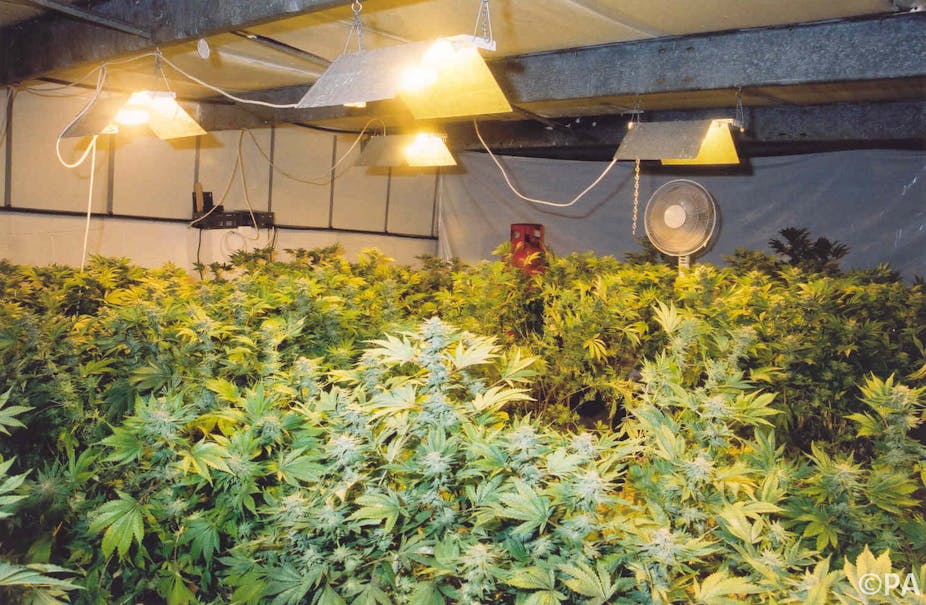Sourcing unbiased information about the health effects of using cannabis has always been difficult. Government-sponsored propaganda was evident as far back as the 1930s in the film Reefer Madness, which had a central message (in case you hadn’t guessed it from the title) that using cannabis will induce some form of crazed mental disturbance.

This link has persisted to the present day. The latest concerns centre on the strain of cannabis known as skunk and its association with cannabis psychosis, especially in young people. Cannabis psychosis describes a range of symptoms such as hallucinations, distortions of reality and difficulty in thinking or problem solving.
The debate relates to the higher proportion of ∆-9-tetrahydrocannabinol (THC) and lower amount of cannabidiols (CBD) in skunk that are believed, depending on the ratio of each, to increase the probability of developing cannabis psychosis. Both are cannabinoids, the psychoactive chemicals found in cannabis.
Both compounds are present in all varieties of cannabis but it’s the inconsistent proportion of each that is thought to either reduce or enhance the likelihood of developing psychosis. Studies have shown that a higher proportion of CBDs in certain types of cannabis, such as cannabis resin, provide a modest anti-psychotic effect, while strains with a higher presence of THC such as skunk increase the risk of psychosis.
Although some of these studies have produced a statistically significant effect, this does not always translate into clinical significance. For example, the cannabis users in these studies may have shown a small but statistically significant change in a score on a psychiatric assessment tool which makes no meaningful difference to their life.
Cannabis use has been declining steadily over the last ten years in the UK but there has been a dramatic change in the availability of cannabis, moving mainly from cannabis resin to the hydroponically-bred varieties of cannabis such as skunk. However it is difficult to get an accurate picture of which types of cannabis are available, due to the illicit nature of cannabis supply and use.

Home Office data on police seizures has been used as a proxy for supply of cannabis in the UK. This indicates that from 2002 to 2012 cannabis resin seizures fell by 60% and herbal cannabis (including skunk) increased by 250%. The Home Office figures are problematic as they represent a fraction of the cannabis that is available and only that which is seized, which may not be typical of what is accessible to most users.
Drug use is known to vary significantly geographically, so the sample of police seizures may also not be indicative of the type of cannabis that is available to people in differing parts of the country.
A further problem lies in the term cannabis psychosis itself. The main issue is how it is interpreted by the psychiatrists who are responsible for assessing individuals and giving this diagnosis. They have to be able to connect the person’s cannabis use with the broad range of symptoms and presenting behaviours that categorise psychosis. It isn’t clear how much cannabis you need to ingest to qualify for this diagnosis, or over how long a period, or indeed how intense your use should have been.
This is complicated by the biological tests that are used routinely used to screen patients for cannabis use, as cannabis metabolites can be detected weeks after use, potentially leading to false positive results.
It is possible that each psychiatrist will use varying parameters to determine whether cannabis is the cause of psychotic symptoms in patients. We need to understand how psychiatrists assess and make decisions for diagnosis.
The problems in determining the relationship between cannabis use and psychosis are also reflected at a policy level. Cannabis is regulated under the 1971 Misuse of Drugs Act and it has moved up and down this hierarchical system over the previous ten years - it is now a Class B drug, but was in class C from 2004 to 2009.

It was also in 2009 that David Nutt, head of the Advisory Council on the Misuse of Drugs was forced to step down after saying that cannabis was less harmful than alcohol or nicotine.
The current classification of cannabis came about as politicians expressed their increasing concern about the links between the increasing use of skunk and severe mental health problems and particularly psychosis. If the intention was to reduce the incidence of cannabis psychosis by elevating cannabis to class B then one measure that this has been effective would be to record a reduction in hospital admissions for cannabis psychosis.
However when we analysed the data we found the opposite was true: hospital admissions were falling during the years from 2004 to 2009 when cannabis was in class C, then rose following the upgrade to class B in 2009.
To put all this into perspective, recent estimates suggest that thousands of young people would need to be prevented from using cannabis to prevent one case of cannabis psychosis.
If we are to understand the relationship between cannabis and psychosis it’s essential that we move beyond the often well-rehearsed polarised arguments from those lobbying for decriminalisation or legalisation of cannabis (including for economic reasons) and those who over-emphasise the health risks.
We need to investigate some basic issues such as what type of cannabis is being used and how intensely. This could be done by an annual survey that would provide a more detailed and informative picture than the official snapshot using police seizures. Then we might hope to build a fuller picture and make decisions about cannabis and its strains based on more evidence.

